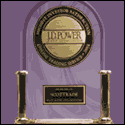|
Related Links
Discussion Boards
Latest Fool.com Headlines
|
Is the Price of Power Getting You Down?
By
If you've been paying attention to things small during the last several years, you probably know that nanotechnology presents the promise of revolutionizing many areas of our lives, including medicine, semiconductor manufacturing, display technology, and even the game of golf. Another area where nanotechnology may cause a big splash is solar power.
All solar technologies must balance the three requirements that make solar power price-competitive with other methods of power generation: efficiency (the fraction of light energy that is converted to electricity), manufacturing cost, and longevity. Cypress Semiconductor (NYSE: CY) spinoff SunPower (Nasdaq: SPWR), for example, makes its solar cells from thick pieces of silicon. The resulting solar cells have an efficiency of around 20%, but these cells are expensive to manufacture due to the large amount of silicon required. Other manufacturers like DayStar (Nasdaq: DSTI) make solar cells that consume less raw material by using thin films. Though thin-film solar cells can be less expensive to manufacture, the resulting cells are less efficient than those made from thicker material.
With nanotechnology, it may be possible to optimize these three requirements. A private company called Nanosolar claims to have developed a technology that allows it to build solar panels with these characteristics.
Nanosolar has developed a semiconductor ink that allows it to make a solar cell using a simple printing process. The ink is deposited on a flexible substrate (the "paper"), and the nanocomponents in the ink align themselves properly via molecular self-assembly.
This method has several advantages. One advantage is that the printing process makes it easy to deposit a uniform layer of the ink, resulting in a layer with the correct ratio of elements everywhere on the substrate. Second, the ink is printed only where needed, so there is no waste of material. Last, the substrate material (the "paper") on which the ink is printed is much less expensive than the stainless steel substrates that are often used in thin-film solar panels.
Nanosolar claims that these solar cells successfully blend the needs for efficiency, low cost, and longevity. Furthermore, the solar panels will be easy to install due to their flexibility and light weight. Unfortunately, Nanosolar is not yet a public company, so ordinary folks can't invest in it yet. But since it looks like high energy prices are going to stay with us for awhile, maybe we'll see a Nanosolar IPO at some point in the future.
For more nano-Foolishness, check these out:
Interested in nanotech, biotech, high tech, anything tech? Try a free trial to the Motley Fool Rule Breakers newsletter service and see which companies David Gardner thinks will be the next big very small thing.
Fool contributor Dan Bloom owns shares of Cypress Semiconductor. The Motley Fool has an ironclad disclosure policy.





![Subscribe to Fool.com Headlines
[RSS 2.0]](motley_files/rss_30x14.gif)